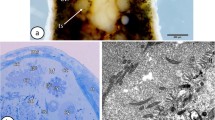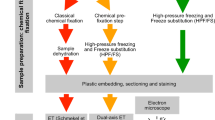Summary
Assuming a possible role of calcium in the function of the germinal proliferation centre in the testis ofDrosophila melanogaster, the distribution of Ca2+-binding protein parvalbumin and structural related proteins in male gonads was tested by several biochemical and immunohistochemical methods. The two dimensional PAGE analysis on 3000 gonads of pupal stages suggests the presence of parvalbumin in this tissue. Immunohistochemical studies confirmed this finding. Parvalbumin-immunoreactivity was located in (or near) membraneous systems, like mitochondria and (or) microtubuli. The immunohistochemical analysis of irradiated gonads showed no radiation damage effect on the distribution of parvalbumin in certain cells and cell components.
Similar content being viewed by others
Abbreviations
- EDTA:
-
ethylenediaminetetraacetate
- PAGE:
-
polyacrylamid-gelelectrophoresis
- pI:
-
isolectric point
- Mr :
-
relative molecular mass
References
Berchtold MW, Wilson KJ, Heizmann CW (1982) Isolation of neuronal parvalbumin by high-performance liquid chromatography. Characterization and comparison with muscle parvalbumin. Biochemistry 21:6552–6557
Berchtold MW, Heizmann CW, Wilson KJ (1983) Ca2+-binding proteins: a comparative study of their behavior during high-performance liquid chromatography using gradient elution on reverse-phase supports. Anal Biochem 129:120–131
Chafouleas JG, Bolton WE, Hidaka H, Boyd AE, Means AR (1982) Calmodulin and the cell cylce: involvement in regulation of cell-cycle progression. Cell 28:41–50
Cox JA (1986) Isolation and characterization of new Mr=18,000 protein with calcium vector properties in Amphioxus muscle and identification of its endogenous target protein. J Biol Chem 261:13173–13178
Cuthbertson KSR, Whittingham DG, Cobbold PH (1981) Free Ca2+ increases in exponential phases during mouse oocyte activation. Nature 294:24/31:754–757
Fritz-Niggli H, Suda T (1987) Role of the germinal centre ofDrosophila melanogaster: the presence of a master cell. Mutat Res 192:47–53
Gerday Ch (1982) Soluble calcium-binding proteins from fish and invertebrate muscle. Mol Physiol 2:63–87
Hardy RW, Tokuyasu KT, Lindsley DL, Garavito M (1979) The germinal proliferation center in the testis ofDrosophila melanogaster. J Ultrastr Res 69:180–190
Heizmann CW (1984) Parvalbumin, an intracellular calcium-binding protein; distribution, properties and possible roles in mammalian cells. Experientia 40:910–921
Heizmann CW, Berchtold MW (1987) Expression of parvalbumin and other Ca2+-binding proteins in normal and tumor cells: a topical review. Cell Calcium 8:1–41
Heizmann CW, Celio MR (1987) Immunolocalization of parvalbumin. Methods Enzymol 139:552–570
Kägi U, Berchtold MW, Heizmann CW (1987) Ca2+-binding parvalbumin in rat testis. Characterization, localization, and expression during development. J Biol Chem 262:7314–7320
Kägi U, Berchtold MW, Heizmann CW (1986) Expression of the Ca2+-binding parvalbumin during development of rat testis. In: Stefanini M et al. (eds) Proceedings of the IVth European Workshop on Molecular and Cellular Endocrinology of the Testis. Elsevier (Biomedical Division), Amsterdam, pp 165–171
Kägi U, Chafouleas J.G, Norman AW, Heizmann CW (1987) Developmental appearance of the Ca2+-binding proteins parvalbumin, calbindin D-28K, S-100 proteins and calmodulin during development of the testis in the rat. Cell Tissue Res (in press)
Klee CB, Vanaman TC (1982) Calmodulin. In: Anfinsen CB, Edsall JT, Richards FM (eds) Advances in protein chemistry, vol 35. Academic Press, New York London, pp 213–321
Kretsinger RH (1980) Structure and evolution of calcium-modulated proteins. CRC Crit Rev Biochem 8:119–174
Means AR, Tash JS, Chafouleas JG (1982) Physiological implications of the presence, distribution and regulation of calmodulin in eukaryotic cells. Physiol Rev 62:1–39
Oakberg EF (1955) Degeneration of spermatogonia of the mouse following exposure to X-rays and stages in the mitotic cycle at which cell death appears. J Morph 97:39–54
Pfyffer GE, Haemmerli G, Heizmann CW (1984a) Calcium-binding proteins in human carcinoma cell lines. Proc Natl Acad Sci USA 81:6632–6636
Pfyffer GE, Humbel G, Sträuli P, Mohrmann I, Murer H, Heizmann CW (1987) Calcium-binding proteins in carcinoma, neuroblastoma and glioma cell lines. Virchows Arch A 412:135–144
Pfyffer GE, Bologa L, Herschkowitz N, Heizmann CW (1984b) Parvalbumin, a neuronal protein in brain cell cultures. J Neurochem 43:49–57
Sternberger LA (1979) Immunocytochemistry, 2nd edn. Wiley, New York
Wnuk W, Cox JA, Stein EA (1982) Parvalbumins and other soluble high-affinity calcium-binding proteins from muscle. In: Cheung WY (ed) Calcium and cell function, vol 2. Academic Press, New York, pp 243–278
Author information
Authors and Affiliations
Rights and permissions
About this article
Cite this article
Fritz-Niggli, H., Nievergelt-Egido, C. & Heizmann, C.W. Calcium-binding parvalbumin inDrosophila Testis in connection with in vivo irradiation. Radiat Environ Biophys 27, 59–65 (1988). https://doi.org/10.1007/BF01211110
Received:
Accepted:
Issue Date:
DOI: https://doi.org/10.1007/BF01211110




